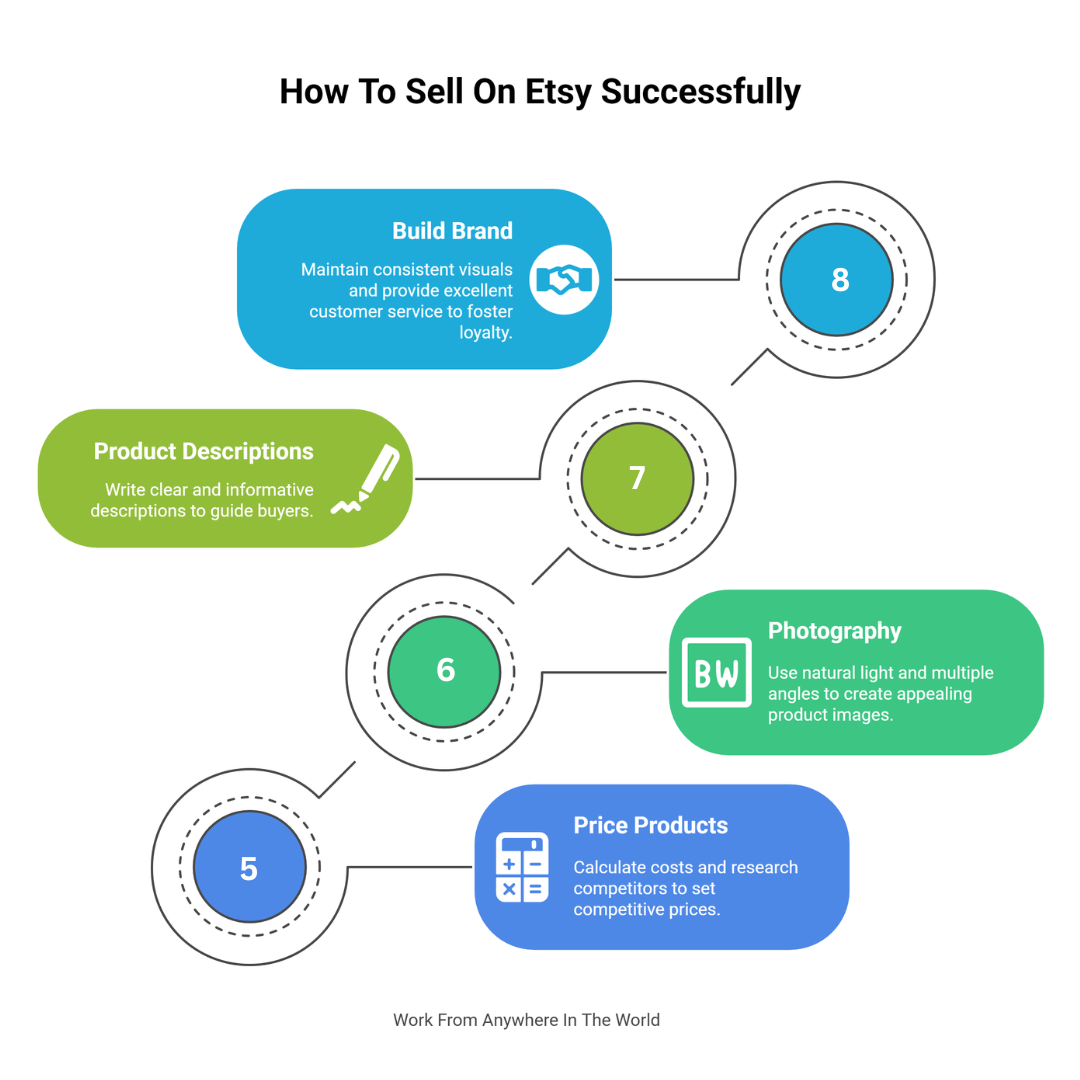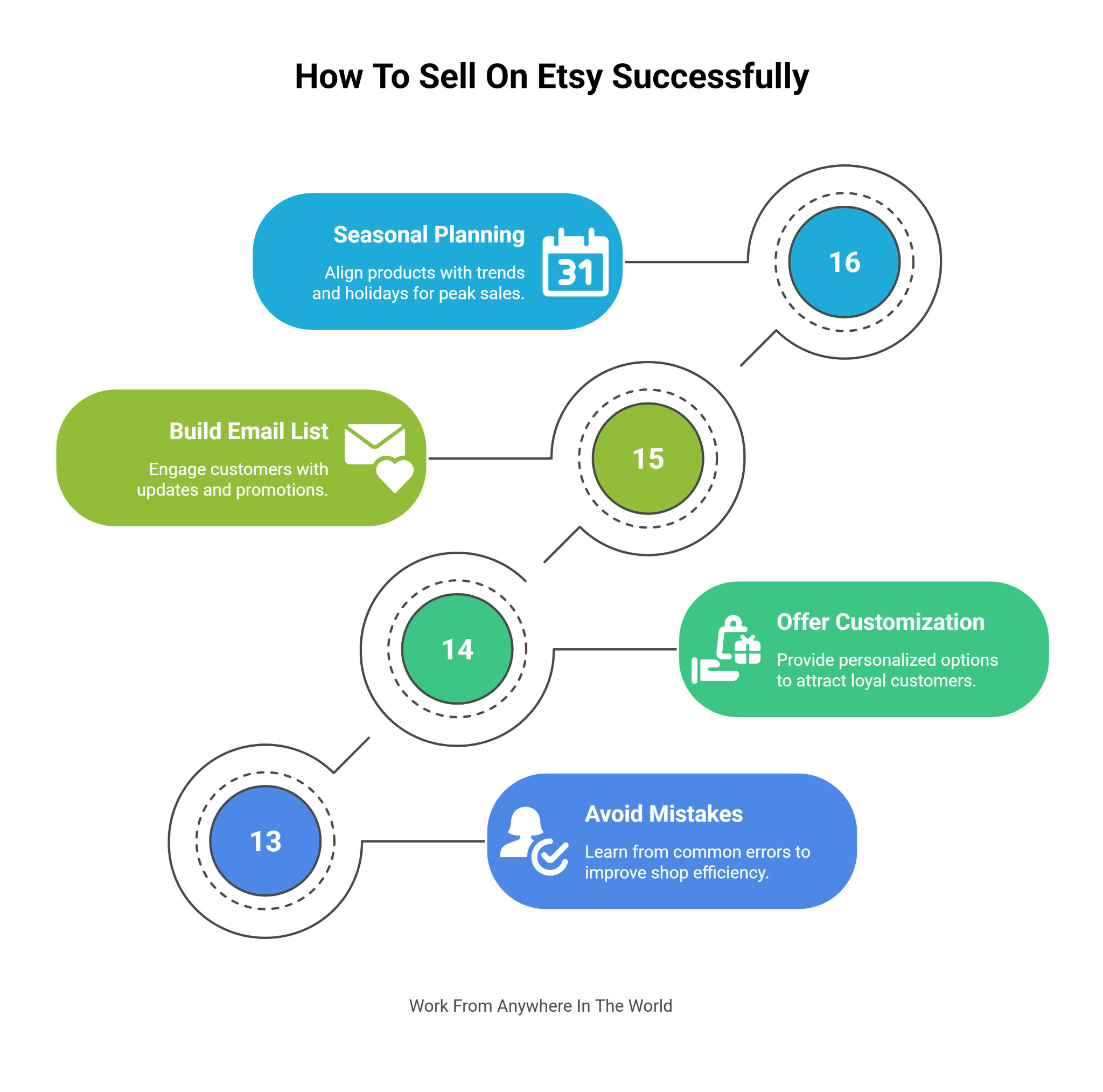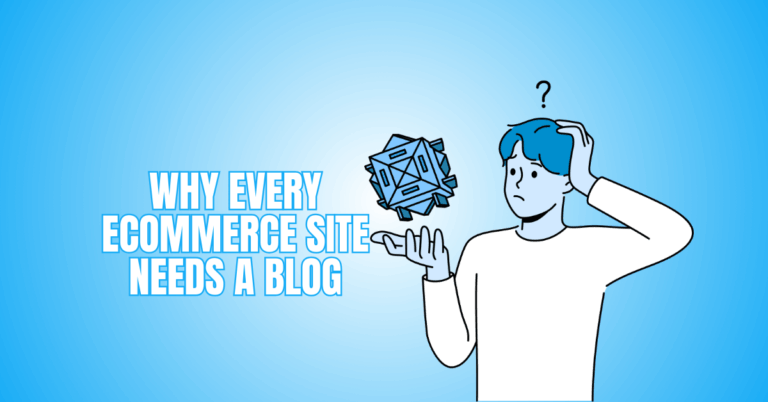How to Sell On Etsy Successfully
If you’ve ever dreamed of turning your creativity into a real business, Etsy is the perfect place to start. But as every successful seller knows, simply listing your products isn’t enough to thrive.
In this post, I’ll walk you through how to sell on Etsy successfully — step by step. You’ll learn how to set up your shop the right way, create listings that attract buyers, and build steady sales with confidence.
Whether you’re just opening your first shop or looking to boost an existing one, these practical tips will help you grow your Etsy business and achieve the success your creativity deserves.
How To Sell On Etsy Successfully
Step 1: Choose Your Niche
Choosing the right niche is one of the most critical steps to grow your Etsy shop successfully. Focus on what you are passionate about, as this keeps you motivated.
Research what buyers are searching for and look for products with high demand but low competition. Check competitor listings, pricing, and top-selling items.
Narrowing your niche makes your shop memorable and helps attract loyal customers who return for your unique offerings consistently.
Pro Tips
- Pick a niche you love creating for.
- Check Etsy trends for popular products.
- Study competitors’ best-sellers carefully.
- Start small, then expand gradually.
Step 2: Set Up Your Etsy Shop
Starting with a strong foundation is crucial for Etsy's success. Create an Etsy account first, then pick a shop name that embodies your business and is distinctive and catchy.
An essential first step in learning how to sell on Etsy is creating a polished and well-organized store. Set detailed shop policies covering shipping, returns, and payment methods to build trust.
Make sure your shop looks organized, professional, and welcoming. First impressions matter, as buyers often decide within seconds whether to explore your products. A well-prepared shop increases credibility and encourages sales.
Pro Tips
- Use a simple, memorable shop name
- Create a professional logo and banner
- Clearly outline all shop policies
- Keep branding consistent across listings and profiles
Step 3: Create High-Quality Listings
Listings are the heart of your Etsy shop and the main way to attract buyers. Start with product titles that include relevant keywords buyers are searching for.
Write clear, engaging, and detailed descriptions that explain what the product is, its benefits, and how to use it. Use bright, high-quality photos showing multiple angles to give buyers a complete view.
Set prices that are competitive but still profitable, factoring in Etsy fees and shipping costs. Use keywords naturally throughout titles and descriptions to help your products appear in search results.
Pro Tips
- Include primary keywords in product titles
- Write descriptions that answer buyer questions clearly
- Use high-quality photos showing multiple angles
- Factor Etsy fees into your pricing strategy
Step 4: Optimize For Etsy SEO
Etsy SEO is essential for making your products visible to buyers. Start by using strong keywords in titles, tags, and descriptions that match what people search for.
Add relevant categories and attributes to help Etsy categorize your products correctly. Refresh your listings regularly to show activity and signal the algorithm that your shop is active.
Encourage satisfied buyers to leave reviews, as higher ratings boost search ranking. SEO is not a one-time task. Continuously monitor trends, adjust keywords, and optimize your listings to stay competitive and attract more traffic to your shop.
Pro Tips
- Use keywords naturally in titles and descriptions
- Select accurate categories for every product listing
- Update listings regularly to improve Etsy search ranking
- Encourage buyers to leave reviews consistently and politely

Step 5: Price Your Products Correctly
Learning how to sell on Etsy successfully requires knowing how to set the correct prices. Start by calculating the cost of materials and the time it takes to make each item.
Include Etsy fees and payment processing costs to avoid losing money—research competitors’ pricing for similar products to stay competitive. Consider the perceived value of your items; unique or handmade products can often command higher prices.
Avoid underpricing just to attract sales, as this can hurt your profit and brand reputation. Focus on creating value for buyers while keeping your business sustainable over time.
Pro Tips
- Calculate all material and labour costs carefully
- Include Etsy fees in your final price
- Research competitor pricing before setting your prices
- Price unique items higher based on perceived value
Step 6: Photography That Sells
Photos are the first impression buyers get of your products. High-quality images increase clicks, engagement, and sales.
Use natural light to make your photos clear and vibrant. Show multiple angles and highlight essential details so buyers can see exactly what they’re getting.
Include lifestyle images to demonstrate how the product is used in real life. Maintain a consistent style across all listings to create a professional and cohesive shop appearance.
Investing time in photography helps your products stand out and builds buyer trust, making your shop more likely to attract repeat customers.
Pro Tips
- Use natural light for bright, clear images.
- Capture multiple angles to show product details.
- Include lifestyle images to illustrate product usage.
- Keep a consistent visual style across listings.
Step 7: Write Compelling Product Descriptions
Product descriptions guide buyers and help them decide to purchase. Clearly state what the product is, including dimensions, materials, and available colours.
Explain the benefits and uses so buyers understand its value. Include shipping details and care instructions to set clear expectations and reduce confusion.
Write in short paragraphs and use bullet points to make the description easy to read. Incorporate relevant keywords naturally to improve Etsy search visibility.
A well-written description builds trust, reduces questions, and increases conversions, helping your shop appear professional and encouraging buyers to complete their purchase confidently.
Pro Tips
- Clearly state product details and materials used
- Highlight product benefits and practical uses
- Include shipping and care instructions for clarity
- Use relevant keywords naturally for better Etsy search visibility
Step 8: Build Your Brand
Building a strong, recognizable brand is essential for learning how to sell on Etsy successfully. Maintain consistent visuals across your shop, including listings, banners, and social media, to reinforce recognition.
Share a unique story about your business or products to connect emotionally with buyers. Provide excellent customer service by responding promptly, solving issues fairly, and creating a positive buying experience.
A strong brand encourages repeat purchases and builds long-term loyalty. Repeat buyers are often the foundation of sustainable Etsy success. Investing in branding helps your shop stand out, attract dedicated customers, and increase overall sales over time.
Pro Tips
- Keep visuals consistent across all platforms
- Share your business story to engage buyers
- Provide fast, helpful, and friendly customer service
- Encourage repeat purchases through loyalty and trust building

Step 9: Promote Your Shop
To increase traffic and sales to your Etsy store, marketing is crucial. Use social media sites like Instagram, Pinterest, and TikTok to advertise your goods to expand your customer base.
Collaborate with influencers or bloggers who align with your niche to gain credibility and exposure. Use Etsy ads to target potential buyers and increase visibility for key listings.
Participate in Etsy forums and communities to network, share tips, and attract interested buyers. Consistent and strategic promotion builds brand awareness, increases traffic, and boosts sales, helping your shop grow steadily over time.
Pro Tips
- Post regularly on social media platforms for visibility
- Collaborate with influencers to expand your reach effectively
- Run targeted Etsy ads to increase listing exposure
- Engage in Etsy communities to attract potential buyers
Step 10: Manage Shipping Efficiently
Shipping that is dependable and quick is essential to satisfying Etsy customers. Give them a variety of shipping alternatives so they may select the one that works best for them.
Use tracked shipping to give buyers peace of mind and reduce disputes. Use cushioning or strong boxes to package goods safely to avoid damage during transportation.
Factor shipping costs into your pricing to ensure profitability without surprising buyers. A smooth shipping experience encourages positive reviews and repeat purchases, building your shop’s reputation.
Efficient shipping shows professionalism and care, which strengthens buyer trust and loyalty, ultimately helping your Etsy business grow sustainably over time.
Pro Tips
- Provide multiple shipping options for buyer convenience
- Use tracked shipping to reassure and protect buyers
- Package items carefully to prevent shipping damage
- Include shipping costs when calculating product pricing
Step 11: Handle Customer Service Professionally
To succeed as an Etsy vendor, one must cultivate good customer service abilities. Respond to buyer messages quickly to show attentiveness and professionalism.
Address issues politely and reasonably to resolve problems and build trust. Always thank customers after a purchase to create a positive experience.
Encourage reviews and feedback, as these improve credibility and attract new buyers. The likelihood that a satisfied customer would come back and recommend your store to others rises.
Consistent, friendly, and helpful communication strengthens relationships, builds loyalty, and enhances your shop’s reputation, making customer service a key factor in long-term Etsy success.
Pro Tips
- Respond to buyer messages as quickly as possible
- Handle issues politely to maintain customer trust
- Always thank customers for their purchases kindly
- Encourage reviews and feedback from satisfied buyers
Wealthy Affiliate – Mini Review (2025)
If you’ve ever thought about turning your blog, passion, or niche into an online business,
Wealthy Affiliate (WA) is one of the most beginner-friendly platforms I’ve used.
It combines step-by-step training, website hosting, SEO research tools,
and an active community all in one place.
What I like most: you can start free (no credit card needed),
explore lessons, test the tools, and connect with other entrepreneurs
before upgrading. WA isn’t a “get rich quick” scheme — it’s a platform where success comes
from consistent effort and applying what you learn.
Step 12: Monitor Performance
Regularly monitoring Etsy analytics is essential to understand what drives your shop’s success. Track top-performing products to know which items sell best.
Examine traffic sources, such as social media, search, or advertisements, to determine the origins of visitors. Adjust listings based on trends, including updating titles, tags, or photos to improve visibility.
Experiment with pricing and promotions to find strategies that boost sales and profitability. Using data to guide decisions helps your shop grow efficiently and sustainably.
By eliminating uncertainty, analytics provide you with the ability to concentrate on tactics that yield tangible outcomes.
Pro Tips
- Monitor top-selling products to identify customer favourites
- Check traffic sources to understand buyer behaviour clearly
- Update listings regularly to reflect current trends
- Test pricing and promotions to maximize revenue potential

Step 13: Avoid Common Mistakes
Avoiding common mistakes is key to Etsy's success. Poor photography can make your products look unappealing, reducing clicks and sales.
Weak SEO or missing keywords make it harder for buyers to find your listings in search results. Ignoring customer messages or complaints can damage your reputation and discourage repeat buyers.
Underpricing or overpricing products can hurt profitability and sales volume. Learn from these mistakes early to save time and increase revenue.
Focus on improving images, optimizing listings with strong keywords, responding promptly to customers, and setting fair prices to ensure your shop grows efficiently and sustainably.
Pro Tips
- Take high-quality photos to showcase products effectively
- Use relevant keywords to improve Etsy search ranking
- Respond promptly to all customer inquiries professionally
- Price products strategically to balance sales and profits
Step 14: Offer Customization Options
Offering customization options is an effective strategy to learn how to sell on Etsy successfully. Many customers love items they can customize to reflect their style or needs.
Let buyers choose colours, sizes, or add personal text like names or messages. Clearly highlight these options in your product titles, descriptions, and photos so customers understand what’s available.
Show examples of customized products in images to inspire confidence. Personalization adds value, makes your products stand out, and encourages repeat purchases.
By making customization easy and visible, you create a unique shopping experience that attracts loyal and satisfied buyers.
Pro Tips
- Clearly mention customization options in product titles
- Show examples of personalized products in product photos
- Offer multiple personalization choices, like colours or sizes
- Explain how buyers can provide custom details clearly
Step 15: Build An Email List
One of the most effective ways to expand your Etsy business is to build an email list. Collect emails from buyers and interested visitors to stay in touch and share updates about new products or special offers.
Offer incentives like discounts, free guides, or exclusive content to encourage sign-ups. Use email campaigns to promote products, announce sales, or share behind-the-scenes stories, which helps increase repeat purchases and loyalty.
Keep your emails engaging, concise, and visually appealing. Regular communication builds trust and keeps your shop top-of-mind for customers, turning one-time buyers into long-term supporters and boosting overall sales over time.
Pro Tips
- Offer discounts to encourage newsletter sign-ups immediately
- Send regular emails with engaging product updates
- Include clear calls-to-action in every email campaign
- Segment your email list for targeted promotions effectively
Step 16: Seasonal And Trend Planning
Seasonal and trend planning is essential for maximizing Etsy sales. Create products that align with holidays, seasons, or current trends, as these often see higher buyer demand.
For example, offer festive items during Christmas or summer-themed products in warmer months. Regularly check Etsy trends, search data, and popular keywords to identify what’s in demand.
Adjust your inventory and listings based on these insights to stay relevant. Seasonal planning helps you capitalize on peak shopping periods and keeps your shop fresh.
Staying ahead of trends ensures buyers find your products timely and appealing, increasing both visibility and sales.
Pro Tips
- Create products for upcoming holidays and seasonal events
- Monitor Etsy trends to identify high-demand items quickly
- Adjust inventory based on current search and buyer behaviour
- Update listings to reflect seasonal or trending products effectively

FAQs
1. Do I Need A Business License To Sell On Etsy?
In most places, you can begin selling on Etsy without a company license. However, depending on your country, state, or city regulations, you may need to register for taxes or a business license if your sales reach a certain threshold. Always check local laws to avoid penalties.
2. How Much Does It Cost To Sell On Etsy?
Etsy levies a 6.5% transaction fee on the selling price (including delivery) in addition to a $0.20 listing fee for each item. Additional fees may apply for payment processing. Many sellers also invest in Etsy Ads or subscription plans like Etsy Plus for better visibility.
3. How Do I Choose The Right Product To Sell?
Focus on items that match your skills and passion while having market demand. Research Etsy’s trending categories, check competitor shops, and consider seasonal demand. Handmade, vintage, and unique personalized items tend to perform well.
4. How Do I Price My Products Effectively?
Consider your costs (materials, labour, shipping), Etsy fees, and competitor pricing—factor in profit margins and perceived value. Avoid underpricing; a price too low may devalue your brand, while a price too high may deter buyers.
5. How Can I Optimize My Etsy Listings For Search?
Use clear titles, detailed descriptions, and relevant tags. Incorporate keywords buyers are likely to search for. High-quality images, thorough product details, and accurate categories help your listings rank better in Etsy search.
6. How Do I Handle Shipping?
Decide whether to ship internationally or locally. Use Etsy’s shipping calculator to determine costs and delivery times. Offer tracking options when possible. Fast and reliable shipping improves buyer trust and reviews.
7. How Do I Get More Etsy Reviews?
Offer precise product descriptions, prompt shipping, and first-rate customer service. Include a personalized thank-you note to encourage reviews. Avoid incentivizing reviews directly, as Etsy’s policies prohibit this.
8. How Can I Promote My Etsy Shop Outside Etsy?
Leverage social media (Instagram, Pinterest, TikTok) to showcase products, run targeted ads, and collaborate with influencers. Build an email list and consider a small blog or website to increase visibility and drive traffic.
9. How Long Does It Take To Become Successful On Etsy?
Success varies depending on product niche, marketing, and consistency. Some sellers see results in a few months, while others take a year or more. Persistence, learning trends, and constantly optimizing listings are key.
Conclusion
Selling on Etsy successfully requires strategy, creativity, and consistency. Focus on creating high-quality products, optimizing listings with strong SEO, and taking professional photos.
Following these proven strategies teaches you how to sell on Etsy successfully and grow your business sustainably. With dedication and an innovative approach, your Etsy shop can thrive and achieve long-term success.
I trust you enjoyed this article on How to Sell On Etsy Successfully. Please stay tuned for more insightful blogs on affiliate marketing, online business, and working from anywhere in the world.
Take care!
— JeannetteZ
💬 Your Opinion Is Important To Me
Do you have thoughts, ideas, or questions? I’d love to hear from you. Please leave your comments below or email me directly at Jeannette@WorkFromAnywhereInTheWorld.com.
📚 More Work From Anywhere Reads
🚀 Ready to Build a Business You Can Run from Home
Or from Anywhere in the World?
Imagine creating income on your terms — from home, a cozy café, or wherever life takes you.
With the right tools, training, and community support, it’s entirely possible.
Start your own online business for free — no credit card needed.
Disclosure
This post may contain affiliate links. As an Amazon Associate and participant in other affiliate programs, I earn from qualifying purchases at no extra cost to you. Please read my full affiliate disclosure.







